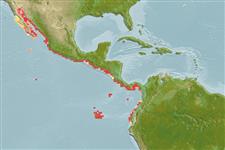Environment: milieu / climate zone / depth range / distribution range
Ecologia
marinhas; intervalo de profundidade 0 - 50 m (Ref. 189). Tropical; 33°N - 3°S, 116°W - 77°W (Ref. 189)
Eastern Central Pacific: southwestern coast of Baja California, Mexico and the Gulf of California to Panama and the Galápagos Islands.
Tamanho / Peso / Idade
Maturity: Lm ? range ? - ? cm
Max length : 17.0 cm TL macho/indeterminado; (Ref. 114986); common length : 9.5 cm SL macho/indeterminado; (Ref. 9298)
Descrição suscinta
Chaves de identificação | Morfologia | Morfometria
Espinhos dorsais (total) : 0; Espinhos anais: 0; Raios anais : 15 - 19. Body rather elongate, but somewhat compressed. Snout moderate, about 3/4 eye diameter; maxilla moderate, tip narrowly pointed, reaching onto sub-operculum, but not to edge of gill cover; gill cover canals of panamensis-type. Anal fin short, its origin below posterior third of dorsal fin base. A narrow silver stripe along flank, deeper above anal fin (about 3/4 to 2/3 eye diameter).
A schooling species occurring in coastal waters. Pelagic. Frequently caught over sand or gravel in the Gulf of Nicoya, Costa Rica, but also over mud.
Ciclo de vida ou comportamento de acasalamento
Maturidade | Reprodução | Desova | Ovos | Fecundidade | Larvas
May spawn throughout the year in the Gulf of Nicoya, Costa Rica (Ref. 189). Spawn in school (Ref. 205).
Whitehead, P.J.P., G.J. Nelson and T. Wongratana, 1988. FAO Species Catalogue. Vol. 7. Clupeoid fishes of the world (Suborder Clupeoidei). An annotated and illustrated catalogue of the herrings, sardines, pilchards, sprats, shads, anchovies and wolf-herrings. FAO Fish. Synop. 125(7/2):305-579. Rome: FAO. (Ref. 189)
Status na Lista Vermelha da UICN (Ref. 130435: Version 2024-1)
Ameaça para os humanos
Harmless
Uso pelos humanos
Pescarias: pesca de subsistência
Ferramentas
Relatórios especiais
Baixar XML
Fontes da internet
Estimates based on models
Preferred temperature (Ref.
123201): 20.6 - 28.5, mean 25.8 °C (based on 60 cells).
Índice de diversidade filogenética (Ref.
82804): PD
50 = 0.5000 [Uniqueness, from 0.5 = low to 2.0 = high].
Bayesian length-weight: a=0.00589 (0.00355 - 0.00976), b=3.13 (2.99 - 3.27), in cm total length, based on LWR estimates for this species & Genus-body shape (Ref.
93245).
Nível Trófico (Ref.
69278): 3.4 ±0.4 se; based on size and trophs of closest relatives
Resiliência (Ref.
120179): Elevada, tempo mínimo de duplicação da população menor que 15 meses (Preliminary K or Fecundity.).
Fishing Vulnerability (Ref.
59153): Low vulnerability (10 of 100).
